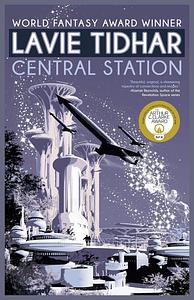Take a photo of a barcode or cover
The first "mosaic" novel I've ever read and I have to say a great introduction to the form. Looking forward to reading one or two more on my list and seeing how my perception changes. 4.5-5 overall.
mysterious
reflective
slow-paced
Plot or Character Driven:
Character
Strong character development:
Complicated
Loveable characters:
Yes
Diverse cast of characters:
Yes
Flaws of characters a main focus:
Yes
Tremendo fix-up. Imaginación desbordante y memorable caracterización. A ratos me recuerda a Ian McDonald ([b:River of Gods|278280|River of Gods (India 2047, #1)|Ian McDonald|https://i.gr-assets.com/images/S/compressed.photo.goodreads.com/books/1388256017l/278280._SX50_.jpg|2440580]) o a China Miéville ([b:Embassytown|9265453|Embassytown|China Miéville|https://i.gr-assets.com/images/S/compressed.photo.goodreads.com/books/1320470326l/9265453._SY75_.jpg|14146240]). A [b:Hyperion|77566|Hyperion (Hyperion Cantos, #1)|Dan Simmons|https://i.gr-assets.com/images/S/compressed.photo.goodreads.com/books/1405546838l/77566._SY75_.jpg|1383900] incluso, aunque a una escala mucho menor.
Outstanding short story collection and easily one of the best science-fiction books of 2016.
Beautifully written, not be the most entertaining SF, more like a snapshot of a possible future.
challenging
reflective
medium-paced
Plot or Character Driven:
Character
Strong character development:
Complicated
Loveable characters:
Complicated
Diverse cast of characters:
Yes
Flaws of characters a main focus:
Complicated
adventurous
challenging
dark
medium-paced
Plot or Character Driven:
Character
Strong character development:
Complicated
Loveable characters:
Yes
Diverse cast of characters:
Yes
Flaws of characters a main focus:
Complicated
For inventive originality, 'Central Station' is remarkable, a five-star read. But it failed to engage me on any other level except for the world-building. So why the high rating? The world of Tel Aviv, Israel, apparently many many centuries far into the future, is mind boggling.
I did not find a character who was appealing to me, gentle reader, but perhaps you might. In any case, I was fascinated and amazed throughout this story by the way people live in this 'reality', a kind of mixed Universe of digital and real life. However, context is often understood belatedly, and not all readers are comfortable with this kind of foreign/English/invented alphabet-soup writing, and some will need to go back and re-read chapters for understanding. Extreme readers of science fiction and most techies will love this book, though.
If you truly want to be surprised by 'Central Station', stop here. This is one of those books best enjoyed as a cold read, but if you must, read on.
Virtual reality is a connective tissue between the people of Earth, Mars, the Moon, the Belt, Jupiter's moons and Saturn because everyone's body is connected to the 'Conversation' through implanted node systems. Bodies can be altered to have red skin and four arms (a Martian affectation), but everyone hears soap operas, talk shows, podcasts, and news reports as a constant oceanic sound in the background. Everyone can see the same augmented reality, apparently something like Pokemon creatures that you see on your phone although they are not really there, floating or walking or interacting with real objects and people. The twist is that some of these virtual reality objects are alive, called the 'Others'. The Others were created in a lab, and they have no idea of physical life, other than occasional contacts with avatar humans in popular digital game worlds.
Humans enter the game world connecting through implanted skin plugins, from inside special pods. However, strange children, found abandoned and adopted by various individuals, seem to sometimes flicker between digital virtual reality and actual reality without any helper devices, being able to access nodes without aids, but as this skill has not been seen by many, it doesn't look as if anyone has taken much notice yet. This world is vast and busy, with many of mankind's older cultures and religions having intermixed and evolved into a melting pot stew.
Tel Aviv is overrun by begging robotic soldiers, surviving on scrap parts and batteries. At some point in the past, uploading human consciousness into computer processors was common, mostly with humans who were dying, like soldiers, and they were put back out into the field to fight wars, which are now long ago history and forgotten. These metal relics, called cyborg robotniks, are now falling apart and are not much respected. It is left to religious organizations to take care of them, but they do so minimally, not having the resources. As a result of their care, and perhaps robotic logic chips, it is the half-human robotic soldiers who seem to have the strongest religious faith, although most people pray and offer gifts to the Oracle, a human who has given up physicality to live entirely 24/7 in virtual reality through a connecting pod.
These future religions are very intermingled in beliefs; for example, there is a Buddhist Jewish sect, so I suspect they are very benign and pacifist. The entire issue of racism seems to be non-issue in this future, since multiple varieties of races and cultures mingle and live side by side. How much human flesh one possesses is where the dividing lines of difference appear to be.
Into this neighborhood surrounding the floating space port called Central Station a data vampire has arrived on a space ship. She has inexplicably passed security. Why? She is a dangerous vampire sucking memories and other data from the minds of those unfortunate enough to be there when she is hungry. She is a pawn, being used by someone for something. What?
This ends as if there will be another book, gentle reader. I hope so.
I did not find a character who was appealing to me, gentle reader, but perhaps you might. In any case, I was fascinated and amazed throughout this story by the way people live in this 'reality', a kind of mixed Universe of digital and real life. However, context is often understood belatedly, and not all readers are comfortable with this kind of foreign/English/invented alphabet-soup writing, and some will need to go back and re-read chapters for understanding. Extreme readers of science fiction and most techies will love this book, though.
If you truly want to be surprised by 'Central Station', stop here. This is one of those books best enjoyed as a cold read, but if you must, read on.
Virtual reality is a connective tissue between the people of Earth, Mars, the Moon, the Belt, Jupiter's moons and Saturn because everyone's body is connected to the 'Conversation' through implanted node systems. Bodies can be altered to have red skin and four arms (a Martian affectation), but everyone hears soap operas, talk shows, podcasts, and news reports as a constant oceanic sound in the background. Everyone can see the same augmented reality, apparently something like Pokemon creatures that you see on your phone although they are not really there, floating or walking or interacting with real objects and people. The twist is that some of these virtual reality objects are alive, called the 'Others'. The Others were created in a lab, and they have no idea of physical life, other than occasional contacts with avatar humans in popular digital game worlds.
Humans enter the game world connecting through implanted skin plugins, from inside special pods. However, strange children, found abandoned and adopted by various individuals, seem to sometimes flicker between digital virtual reality and actual reality without any helper devices, being able to access nodes without aids, but as this skill has not been seen by many, it doesn't look as if anyone has taken much notice yet. This world is vast and busy, with many of mankind's older cultures and religions having intermixed and evolved into a melting pot stew.
Tel Aviv is overrun by begging robotic soldiers, surviving on scrap parts and batteries. At some point in the past, uploading human consciousness into computer processors was common, mostly with humans who were dying, like soldiers, and they were put back out into the field to fight wars, which are now long ago history and forgotten. These metal relics, called cyborg robotniks, are now falling apart and are not much respected. It is left to religious organizations to take care of them, but they do so minimally, not having the resources. As a result of their care, and perhaps robotic logic chips, it is the half-human robotic soldiers who seem to have the strongest religious faith, although most people pray and offer gifts to the Oracle, a human who has given up physicality to live entirely 24/7 in virtual reality through a connecting pod.
These future religions are very intermingled in beliefs; for example, there is a Buddhist Jewish sect, so I suspect they are very benign and pacifist. The entire issue of racism seems to be non-issue in this future, since multiple varieties of races and cultures mingle and live side by side. How much human flesh one possesses is where the dividing lines of difference appear to be.
Into this neighborhood surrounding the floating space port called Central Station a data vampire has arrived on a space ship. She has inexplicably passed security
Spoiler
, which can only mean it was intentionalThis ends as if there will be another book, gentle reader. I hope so.






